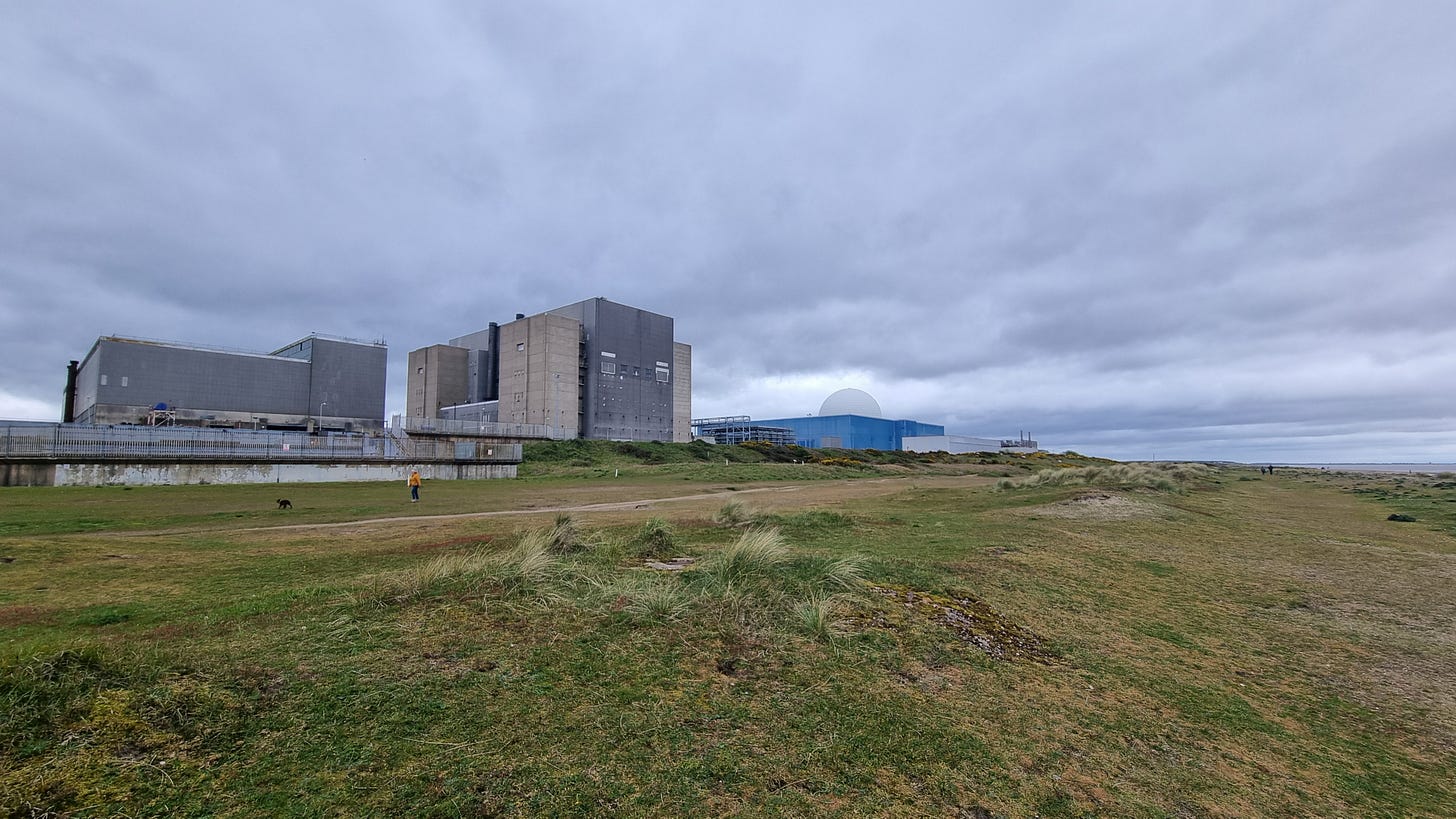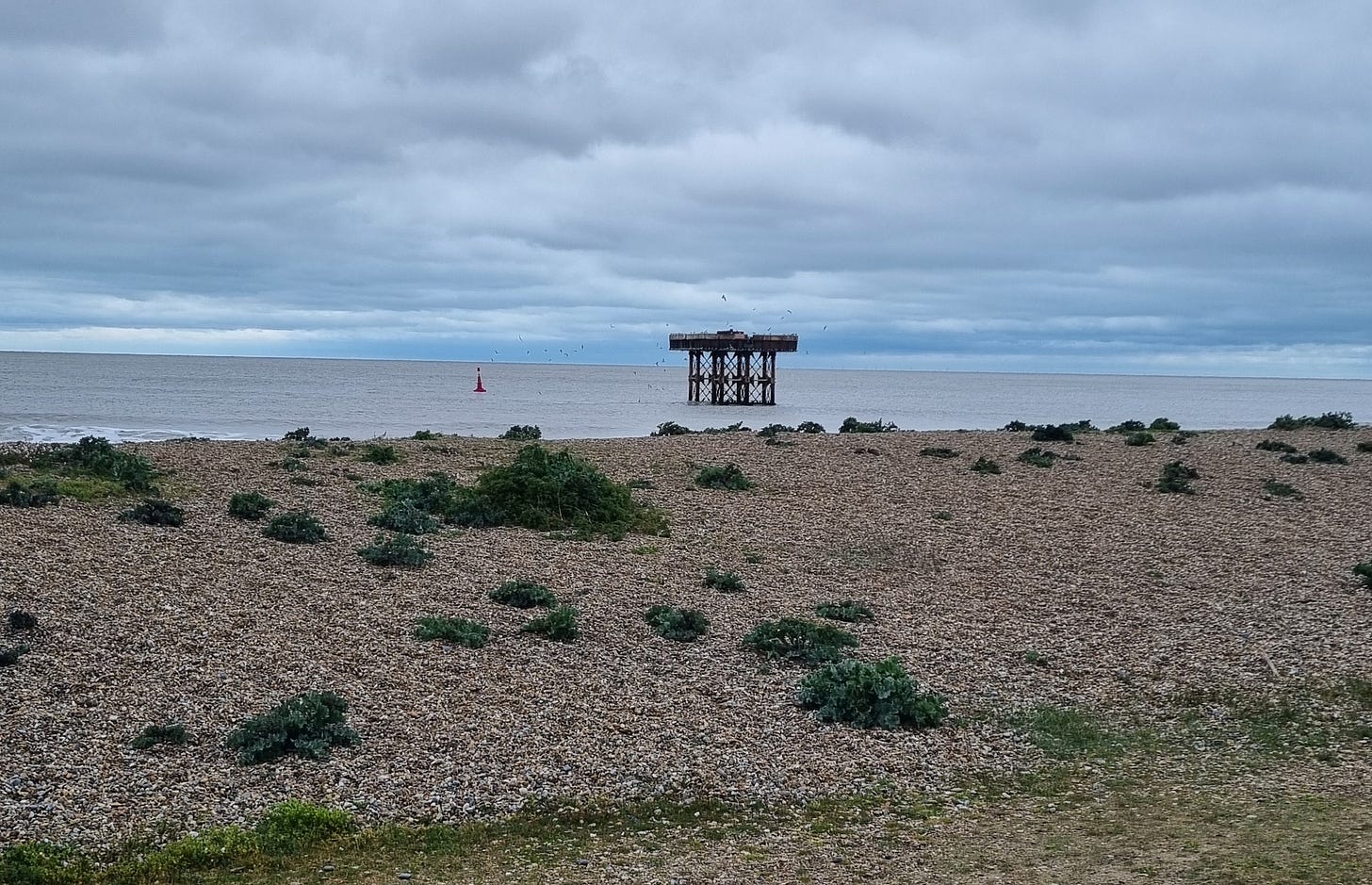Between the power station and the sea
The sonic landscape of Sizewell in Suffolk brings one of the UK's biggest nuclear power stations into relation with a sea whose history of erosion and disaster has long inspired writers and musicians.
I’ve been thinking about how to write about sound, music and environments in the same breath. Or maybe more specifically how to bring one’s own personal experience of a place and its sounds into a dialogue with the music that place has inspired in others. What interests me most about this is to put the political undercurrents, ecological tensions and layered histories of a landscape into a cultural context. The Suffolk coastline in the south east of England is in many ways a perfect place to explore this further, charmed as it is with deep history (both religious and military-industrial), ambiguous landscapes and a significant musical and literary tradition, that includes W.G. Sebald, Mark Fisher and Brian Eno among many others. After a brief visit last weekend, here are a few initial thoughts.
The road down to Sizewell is lined with signs. Red with yellow text, they protest the expansion of a nuclear power plant which is already underway. Sizewell A (now decommissioned) and Sizewell B (very much operational) are to be joined by Sizewell C just a stone’s throw from the shingle beach that stretches along the Suffolk coastline, overlooking what W.G. Sebald called the German Ocean.
This thin strip of beach is a frontier between forces bigger than the human. From the shore, the deep and insidious hum of the power station sets the air on edge, trembles the atoms of the wind, gets beneath your skin, between your bones, enters your soft tissue. It flat-lines, unwavering, unnatural. From the sea, the waves respond on another drone frequency, one that is circular not static, a cumulative ebb and flow that seems to build and build and never break. Between them seagulls skirt the surf. Sea kale grows silently from the stony ground. The sounds blur into one another, a negotiation or a confrontation, played out at the edge of the land.
The Suffolk coastline is one of the most rapidly eroding coastlines in Europe. Here at Sizewell, large dunes used to flank the beach until even two centuries ago. The Sizewell Gap which ran between them was a bountiful route for smugglers who would regularly lead a hundred horses laden with tea and brandy through the passageway under cover of darkness. When a coastal blockade brought the smuggling under control in the early 19th century, tunnels were built from the beach to the cellars of the Vulcan Arms pub a few yards down the road. The existence of an alehouse was first documented in Sizewell as far back as 1540. Closed by Oliver Cromwell in the wake of the Civil War, the pub reopened in the early 1700s, named in honour of the blacksmith that had occupied the building in the intervening years. The ghost of a young lady dressed in black is said to occasionally be seen drifting through the walls of the building.
Today, the beach at Sizewell is said to be among the more stable areas on this stretch of coast. A page on the Sizewell C power station website is dedicated, somewhat poetically, to “Sizewell and the sea”. To build nuclear power stations by the sea feels reckless at best, but there is already an exchange taking place whereby sea water is used – or put to use - in the power station’s cooling system. “Sizewell A has stood on the same part of coastline since 1966 and Sizewell B has operated since 1995,” the website states. “In more than half a century, neither of those power stations has seen any flooding or significant coastal erosion.” While projections suggest that the sea level will not rise significantly if at all, the timescales against which predictions are made feel decidedly human - that is, decidedly limited. In the wake of the Fukushima nuclear disaster in 2011, writer Haruki Murakami called it “a defeat for our imagination.”
There are no fault lines here, but walking towards the spectral dome of Sizewell B, I was reminded of Peter Cusack’s work Sounds From Dangerous Places, the first volume of which features recordings made in the Chernobyl exclusion zone. There is a danger that radiates from nuclear facilities that is hard to really quantify – a sense of all or nothing that lacks gradient or nuance. Radiation that is baked into that insidious hum, because if sound can escape, might that not be all? Cusack’s recordings captured the aftermath of an event which had already taken place, rather than one which could still come.
Eight hundred years ago, the town of Dunwich up the coast from Sizewell was the second largest and most significant port in England, with a population of around 4,000 and a footprint the size of the City of London. Here, Franciscan monks built the Greyfriars Monastery in the 1250s but, with all the will in the world and even a little help from up above, they can’t have imagined it would only last thirty years. In 1286 a ferocious storm swept half of Dunwich into the sea, taking with it the Greyfriars Monastery and much of the population, filling the port with so much silt and rubble that it never recovered. Spires from lost churches and the foundations of flooded houses have since been located under the surf at Dunwich, a good way out to sea from where the village now stands.
On a sunny day, Dunwich beach seems to take in the full sweep of the horizon. To the north the town of Southwold pokes up into the sky. You can’t see it from here, but on the promenade is a Sailors’ Reading Room, built in 1864 to keep the mariners and fishermen out of trouble. To the south, it is the dome of Sizewell B that shimmers in the haze. There is a strangeness, a sense of the uncanny that has drawn many to this place. It is a feeling articulated by the final track of Brian Eno’s 1982 album On Land, ‘Dunwich Beach, Autumn, 1960’.
It is a feeling that emerges throughout W.G. Sebald’s Rings of Saturn and his walks along the flat Suffolk coastline, which in many ways makes this stretch of land the spiritual home of pyschogeography and hauntology - ideas concerned with excavating the ineffable layers of memory and history from the surroundings. It is also that which inspired theorist Mark Fisher and musician Justin Barton to collaborate on an album suitably called On Vanishing Land, which traces a walk from the Felixstowe container port near Ipswich to the Anglo-Saxon burial ground of Sutton Hoo. Yet more sonic reflections of a land that is slippery with stories and meanings.
In 1992, musician Julian Cope released a song called ‘Sizewell B’ that featured on his album Jehovahkill. Cope was no stranger to unplanned tragedy. On his 9th birthday, he was having tea with his grandmother near Aberfan in Wales when an accumulation of heavy rainfall caused the colliery spoil tip above the village to collapse, sending 140,000 cubic yards of slurry sliding down the hillside, killing 116 children and 28 adults. As the residents of Sizewell might suggest - and as those as Dunwich might have done too - things look like they won’t go wrong until they do.
Is it possible to hear in the hum of the power station and the rumble of the sea a foreboding? A sense of intentions not quite aligned, of layers of history accumulated in the silt and shingle of the beach between them. A sense of brinksmanship between mankind and nature, of two forces facing one another down? Standing between them on the beach at Sizewell it would be wise to listen to both.






Also, I think you may like this - about another power station once called ‘Windscale’ and now known as ‘Sellafield’.
https://soundcloud.com/invictus_hi-fi/a-town-called-miasma
Wonderful and insightful read, I know this area well and you capture the experience excellently.